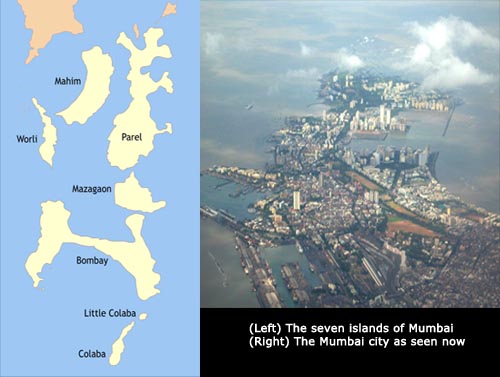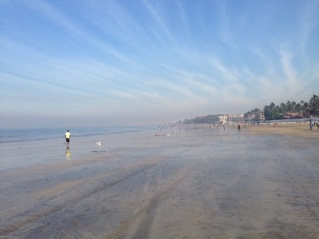Mumbai’s first residents were thought to be deep-sea fisherfolks, called the Kolis, who lived on what were originally seven islands along the shores of the Arabian Sea. Over the centuries, Hindu dynasties, Muslim conquerors, Portuguese and British trading companies, and eventually the British government filled in the spaces in between- both figuratively and quite literally, through land reclamation projects. The seven islands are now joined into one continuous land mass that boasts 20,694 people per square kilometer. For comparison, New York City hosts about 10,760 in the same space.

Since we arrived one week ago, I feel like I’ve spent much more time adjusting to the staggering “urban”-ness of the city than the “other”-ness of the culture. Trade-offs, really. In a city as cosmopolitan as Mumbai, there is such a mix of people, language, and experience that it almost has its own nationality, like the city-state of Singapore (which has a mere 8,350 souls per square kilometer). People here refer to themselves as Mumbaikers, and though most hail a generation or two back from other places, a lot of folks I’ve spoken to feel a strong sense of identity with this crazy town that’s been slapped together with backfilled soil, concrete, and dreams.
Coming from a town of about 100,000 people, I felt the size of the towering buildings and presence of so many people like looking up from the bottom of the deep end of a pool. The same powerlessness that comes from knowing you can’t take a deep breath underwater came from the sense that one little person in a civilization spanning 2,000 years and 20 million people doesn’t amount to much. I guess that’s the sort of thing you buy a plane ticket for.
Like any megatropolis, Mumbai has its neighborhoods.
Bollywood stars live in Bandra and expats flock to Powai, while “informal” housing (a.k.a slums) make up about 54% of the total urban landscape, according to the latest World Bank statistics. Much of this is due to the migratory influx of folks from rural villages, where job options are limited. A great book I’ve been reading, Maximum City, by the journalist Suketu Mehta, makes an interesting point that the problem of overpopulation in the cities of India reflect much on the problems of the country’s rural populations, and that to address one requires attention to the other.
Addin g to the swelling numbers, when we arrived here last week, I wasn’t sure quite where I would squeeze in. Transitioning to city life for me was a challenge, and I can’t guess how folks from tiny villages in Maharashtra manage to make the transition. Used to wide open spaces, my first reaction, oddly enough, was to hide on an island of enclosed, air-conditioned spaces like my hotel room. As a professed “seasoned traveler,” I wasn’t proud of this, but it helped me keep the city out for a few hours and let in just a little at a time. First the surrounding neighborhood, then an auto-rickshaw across town. Tomorrow, I’ll take the train.
g to the swelling numbers, when we arrived here last week, I wasn’t sure quite where I would squeeze in. Transitioning to city life for me was a challenge, and I can’t guess how folks from tiny villages in Maharashtra manage to make the transition. Used to wide open spaces, my first reaction, oddly enough, was to hide on an island of enclosed, air-conditioned spaces like my hotel room. As a professed “seasoned traveler,” I wasn’t proud of this, but it helped me keep the city out for a few hours and let in just a little at a time. First the surrounding neighborhood, then an auto-rickshaw across town. Tomorrow, I’ll take the train.
What helped me most this week was small discoveries of peaceful islands within the ocean of Mumbai.
The grassy Jogger’s Park at the end of Turner Road is filled with bougainvillea and evening strollers. The trees around the campus in Chembur at the Tata Institute of Social Sciences where I’ll be researching look like they’ve been here since the time of the sultans. The jute mats spread on the floor of the Yoga Institute in Santa Cruz make it possible to feel singularly solo while surrounded by a crowd. Yesterday, we found one patch of Juhu Beach where fireworks and cricket games were not currently going off, often at the same time. Island to island, I’ll swim a little farther each time.
It’s been humbling to find myself clinging to shore after a lifetime of seeking out open water. I think as we get older, we float less easily, made denser by the things we are accustomed to. I find myself filling in the parts I don’t know with heavy pockets full of prior experience. This gives me a place to land, but in exchange for the joy of discovery. The resources I have, like money and white privilege, allow me to tread in shallower water than most who newly ply the seas of Mumbai. I hope they don’t keep me from learning to swim here.
Heather,
Thank you so much for sharing your journey with this blog! Really enjoy it!
As an FYI, a friend who works coordinating the Peace Corp World Wise Programs, Caitlin Haugen, is also from Boulder!
Daniel
LikeLike
Reblogged this on Building bridges: A comparative study of women working in the construction industry in India and the US and commented:
This is awonderful piece of writing n Mumbai. Heather is a fellow Fulbrighter. She is a voc tech teacher from Boulder so we have at least two connections: my interest in seeing more young women in voc-tec going into the skilled building trades (“more power tools, fewer hair dryers”) and Harneen is from Boulder. Heather and I will have a lot to talk about when we finally meet on Sunday for a Bird and Bat Tour of Elephanta Island.
LikeLike
India has to be the hardest and most rewarding country to be in. The pollution, the noise, the sheer number of people is overwhelming. India is not for the faint of heart. As you said “there is no growth without productive struggle.” “I feel your pain.”
LikeLike